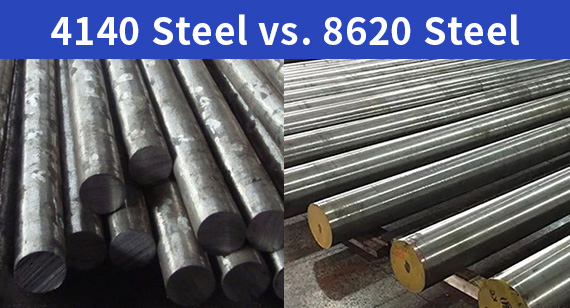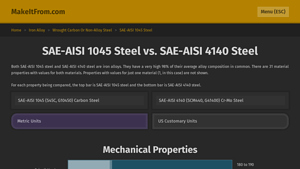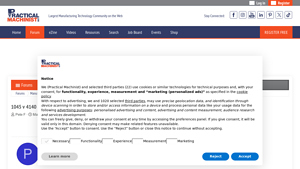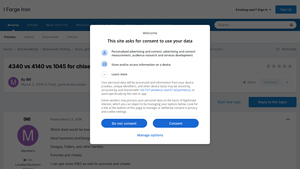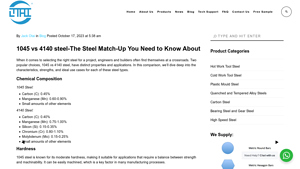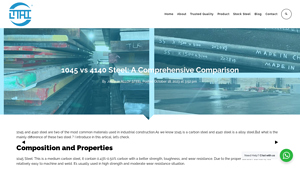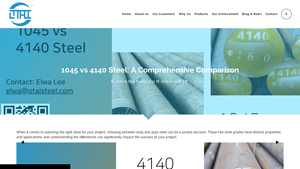4140 Vs 1045 Guide: Type, Cost, Top List…
Introduction: Navigating the Global Market for 4140 vs 1045
In today’s competitive landscape, sourcing the right materials—such as 4140 and 1045 steel—can present significant challenges for international B2B buyers. With each steel grade offering unique properties and applications, understanding their differences is crucial for optimizing performance and cost-effectiveness in industrial projects. This comprehensive guide delves into the essential characteristics of 4140 and 1045 steel, providing insights into their chemical compositions, mechanical properties, and suitability for various applications, from automotive components to high-stress machinery parts.
International buyers from regions like Africa, South America, the Middle East, and Europe—countries such as Nigeria and Germany—will find actionable information on how to effectively vet suppliers, evaluate cost implications, and select the right grade for specific needs. The guide addresses critical questions, including which steel offers better weldability, machinability, and impact resistance, equipping buyers with the knowledge to make informed purchasing decisions.
By understanding the nuances of 4140 and 1045 steel, buyers can not only ensure compliance with international standards but also enhance their procurement strategies, ultimately leading to improved operational efficiencies and reduced production costs. Whether you are looking to optimize your supply chain or seeking high-quality materials for demanding applications, this guide serves as a vital resource for navigating the complexities of the global steel market.
Understanding 4140 vs 1045 Types and Variations
| Type Name | Key Distinguishing Features | Primary B2B Applications | Brief Pros & Cons for Buyers |
|---|---|---|---|
| 4140 Alloy Steel | Contains chromium and molybdenum for enhanced strength and toughness | Gears, axles, heavy machinery | Pros: Superior hardness, ideal for high-stress applications. Cons: Higher cost and more challenging to machine. |
| 1045 Carbon Steel | Higher carbon content, simpler composition | Automotive components, machinery parts | Pros: Cost-effective, good weldability, and machinability. Cons: Lower strength compared to 4140. |
| 4140 HT (Heat Treated) | Increased hardness and strength through heat treatment | Aerospace, oil and gas industries | Pros: Exceptional wear resistance and fatigue strength. Cons: Requires specialized heat treatment processes. |
| 1045 QT (Quenched and Tempered) | Enhanced mechanical properties through quenching | Structural components, tools | Pros: Improved toughness and strength. Cons: More complex processing may increase lead times. |
| 4140 Pre-Hardened | Pre-hardened for immediate use in applications | Tooling, fixtures | Pros: Reduced lead time, ready for machining. Cons: Limited customization options post-hardening. |
What Are the Key Characteristics of 4140 Alloy Steel?
4140 alloy steel is distinguished by its chromium and molybdenum content, which enhances its hardness, toughness, and wear resistance. This steel is typically utilized in applications that demand high strength and resistance to wear, such as gears, axles, and heavy machinery components. For B2B buyers, understanding that 4140 is more expensive than simpler carbon steels like 1045 is crucial, as the upfront investment can lead to longer-lasting components that reduce maintenance costs over time.
How Does 1045 Carbon Steel Compare to 4140?
1045 carbon steel features a simpler composition, primarily consisting of carbon, which makes it a cost-effective option for various industrial applications. It is commonly used in automotive components and machinery parts due to its good weldability and machinability. Buyers should consider that while 1045 is less expensive, it does not offer the same level of strength and wear resistance as 4140, making it suitable for lower-stress applications.
Why Choose 4140 HT for High-Stress Applications?
4140 heat-treated (HT) steel is designed for applications requiring exceptional hardness and strength, achieved through specific heat treatment processes. It is favored in demanding sectors such as aerospace and oil and gas industries. Buyers should note that while the performance benefits are significant, the heat treatment process can add complexity and cost to procurement, necessitating careful consideration of supplier capabilities.
What Are the Advantages of 1045 QT Steel?
1045 quenched and tempered (QT) steel offers improved toughness and strength compared to standard 1045. This treatment process enhances its mechanical properties, making it suitable for structural components and various tools. B2B buyers must weigh the benefits of increased performance against potential lead time increases due to the additional processing involved.
What Should Buyers Know About 4140 Pre-Hardened Steel?
4140 pre-hardened steel is delivered in a ready-to-use state, eliminating the need for further heat treatment before machining. This feature makes it ideal for tooling and fixtures, where immediate usability is crucial. While it reduces lead times, buyers should be aware that the pre-hardened state limits post-processing customization, which could impact the final application.
Key Industrial Applications of 4140 vs 1045
| Industry/Sector | Specific Application of 4140 vs 1045 | Value/Benefit for the Business | Key Sourcing Considerations for this Application |
|---|---|---|---|
| Automotive | 4140 for axles and gears; 1045 for crankshafts | Enhanced performance and durability of components | Ensure compliance with international standards; consider local availability and import tariffs. |
| Oil & Gas | 4140 for drilling equipment; 1045 for pump shafts | Increased reliability in high-stress environments | Evaluate heat treatment options for enhanced properties; assess supplier’s capacity for large orders. |
| Manufacturing | 4140 for tooling and fixtures; 1045 for machine parts | Cost-effective solutions for production efficiency | Source from suppliers with ISO certifications; check for material traceability and testing reports. |
| Construction | 4140 for structural components; 1045 for fasteners | Improved safety and structural integrity | Ensure compliance with local building codes; consider lead times for custom orders. |
| Aerospace | 4140 for landing gear; 1045 for support brackets | Lightweight yet strong materials for safety | Look for suppliers with aerospace-grade certifications; assess global shipping capabilities. |
How is 4140 Steel Used in the Automotive Industry?
In the automotive sector, 4140 steel is commonly utilized for manufacturing high-performance components such as axles and gears, where superior strength and toughness are critical. Its alloying elements, including chromium and molybdenum, enhance its resistance to wear and fatigue, making it ideal for high-stress applications. On the other hand, 1045 steel is often used for crankshafts due to its excellent impact resistance and machinability. Buyers in this sector must ensure that materials meet stringent international automotive standards and consider factors such as local sourcing and cost-effectiveness.
What Role Does 4140 and 1045 Steel Play in the Oil & Gas Industry?
In the oil and gas industry, 4140 steel is favored for drilling equipment, while 1045 is often used for pump shafts. The high tensile strength and durability of 4140 make it suitable for the demanding environments encountered in drilling operations, where equipment is subjected to extreme pressures. Conversely, 1045’s impact resistance makes it ideal for components that require reliable performance under fluctuating conditions. Buyers should consider the availability of heat treatment options to enhance the mechanical properties of these steels and assess suppliers’ capabilities for large-scale orders, especially in regions with developing infrastructure.
How Are 4140 and 1045 Steel Utilized in Manufacturing?
Manufacturing industries leverage 4140 steel for tooling and fixtures, while 1045 steel is commonly used for various machine parts. The hardness and wear resistance of 4140 contribute to longer tool life and improved production efficiency. In contrast, 1045’s ease of machinability allows for cost-effective production of components with complex geometries. Businesses should prioritize sourcing from ISO-certified suppliers who can provide documentation for material quality and traceability, ensuring that products meet industry standards and regulations.
What Are the Applications of 4140 and 1045 Steel in Construction?
In construction, 4140 steel is often employed for structural components, while 1045 is used for fasteners. The superior strength and fatigue resistance of 4140 enhance the safety and structural integrity of buildings and infrastructure. Meanwhile, 1045’s impact resistance is crucial for ensuring the reliability of fasteners under dynamic loads. Buyers must ensure compliance with local building codes and consider lead times for custom orders, particularly in regions with stringent regulatory environments.
How is 4140 and 1045 Steel Applied in Aerospace?
In the aerospace industry, 4140 steel is utilized for critical components such as landing gear, while 1045 is used for support brackets. The lightweight yet robust nature of 4140 is essential for maintaining safety and performance in flight operations. 1045’s excellent machinability allows for the production of intricate support structures. Aerospace buyers should seek suppliers with aerospace-grade certifications and evaluate global shipping capabilities to ensure timely delivery of materials that meet rigorous safety standards.
3 Common User Pain Points for ‘4140 vs 1045’ & Their Solutions
Scenario 1: Choosing the Right Steel for High-Stress Applications
The Problem: A manufacturing company in Germany is tasked with producing high-performance automotive components. The engineering team is torn between using 4140 and 1045 steel. They are concerned that selecting 1045, with its lower yield strength, may lead to premature failure of components under high-stress conditions, while the higher cost of 4140 may stretch their budget unnecessarily. The team needs to make a decision that balances performance and cost-effectiveness.
The Solution: To overcome this challenge, the company should conduct a detailed analysis of the specific application requirements, including load conditions, fatigue life, and environmental factors. They should opt for 4140 steel for components that will experience high stress, such as gears and shafts, due to its superior toughness and wear resistance. However, if certain components can afford to be less robust, 1045 can be used in areas where impact resistance is critical but high strength is not essential. Additionally, sourcing from suppliers who can provide heat-treated 4140 steel will ensure that the components reach their optimal hardness and strength, reducing the risk of failure.
Scenario 2: Managing Budget Constraints While Ensuring Quality
The Problem: A steel fabricator in Nigeria is receiving requests for both 4140 and 1045 steel from various clients but is struggling with budget constraints. Clients are often unaware of the differences in cost and performance, leading to potential misunderstandings regarding the suitability of each steel grade for their projects. This situation creates friction as the fabricator tries to meet client expectations while maintaining profitability.
The Solution: The fabricator should implement a transparent pricing strategy that clearly outlines the benefits and costs associated with both steel types. By providing clients with a comparative analysis of 1045 and 4140, including application scenarios, mechanical properties, and cost implications, the fabricator can educate them on why one option may be more suitable than the other. Additionally, they can leverage bulk purchasing strategies to reduce costs on 4140 steel, allowing them to offer competitive pricing without sacrificing quality. This approach not only improves client relationships but also positions the fabricator as a knowledgeable partner in their clients’ projects.
Scenario 3: Navigating Fabrication and Machining Challenges
The Problem: A machinery parts manufacturer in South America frequently encounters issues with machining 4140 steel due to its hardness. Operators are facing increased tool wear and longer machining times, leading to production delays and higher operational costs. Meanwhile, they are aware that 1045 is easier to machine but are concerned about compromising the strength and durability of the final product.
The Solution: To address this pain point, the manufacturer should invest in high-quality cutting tools specifically designed for machining harder materials like 4140. Utilizing coated carbide or high-speed steel tools can significantly extend tool life and improve machining efficiency. Additionally, implementing advanced machining techniques, such as coolant use and optimized feed rates, can mitigate wear and enhance productivity. For components where machinability is a priority, the manufacturer can reserve 1045 steel, ensuring that they select the most appropriate material based on the specific fabrication requirements. By adopting a tailored approach to machining based on the material properties, the manufacturer can streamline operations while ensuring product quality.
Strategic Material Selection Guide for 4140 vs 1045
What Are the Key Properties of 4140 and 1045 Steel?
When comparing 4140 and 1045 steel, several key properties stand out that are crucial for B2B buyers.
4140 Steel is an alloy steel known for its excellent toughness, wear resistance, and fatigue strength. It typically contains chromium, molybdenum, and manganese, which enhance its mechanical properties. This steel can withstand high temperatures and pressures, making it suitable for demanding applications like gears, axles, and heavy machinery components. Its corrosion resistance is moderate, and it can be heat-treated to achieve higher hardness levels.
1045 Steel, on the other hand, is a carbon steel that offers good strength and impact resistance. Its simpler composition, primarily consisting of carbon and manganese, makes it easier to machine and weld compared to 4140. However, it has lower overall hardness and wear resistance, making it less suitable for high-stress applications. It is often used in manufacturing parts like shafts, bolts, and automotive components.
What Are the Pros and Cons of Each Steel Type?
Pros of 4140 Steel:
– Durability: Exceptional strength and toughness, ideal for high-stress applications.
– Versatility: Suitable for various industries, including automotive, aerospace, and manufacturing.
– Heat Treatment: Can achieve higher hardness and strength through quenching and tempering.
Cons of 4140 Steel:
– Cost: Generally more expensive due to its alloying elements.
– Machining Complexity: Requires advanced machining techniques due to its hardness.
Pros of 1045 Steel:
– Cost-Effective: Lower cost compared to 4140, making it a budget-friendly option for many applications.
– Ease of Machining: Easier to work with due to its lower hardness, which can reduce manufacturing time and costs.
– Good Impact Resistance: Suitable for applications where impact resistance is crucial.
Cons of 1045 Steel:
– Lower Strength: Not as strong or tough as 4140, limiting its use in high-stress environments.
– Weldability Issues: More challenging to weld due to its higher carbon content, which can lead to cracking.
How Do These Materials Impact Specific Applications?
When selecting between 4140 and 1045 steel, the application plays a significant role. 4140 is preferred for high-stress applications, such as gears and axles, where durability and wear resistance are critical. Its ability to withstand harsh conditions makes it ideal for heavy machinery and automotive components.
In contrast, 1045 is often used in applications requiring good impact resistance, such as in the manufacturing of machinery parts and automotive components. Its ease of machining and lower cost make it suitable for mass production where high precision is not as critical.
What Should International B2B Buyers Consider?
For international B2B buyers, particularly from regions like Africa, South America, the Middle East, and Europe, several factors must be considered. Compliance with local standards is essential; for example, ASTM standards are widely recognized, while European buyers may refer to DIN standards. Buyers should also consider the availability of materials in their region, as sourcing can impact lead times and costs.
Additionally, understanding the specific properties of each steel type in relation to local environmental conditions (such as humidity and temperature variations) is crucial for ensuring product longevity and performance.
Summary Table of 4140 vs 1045 Steel
| Material | Typical Use Case for 4140 vs 1045 | Key Advantage | Key Disadvantage/Limitation | Relative Cost (Low/Med/High) |
|---|---|---|---|---|
| 4140 Steel | Gears, axles, heavy machinery components | Exceptional strength and toughness | Higher cost and machining complexity | High |
| 1045 Steel | Machinery parts, automotive components | Cost-effective and easy to machine | Lower strength and weldability issues | Medium |
This analysis provides a comprehensive overview of the strategic material selection between 4140 and 1045 steel, highlighting their properties, advantages, disadvantages, and considerations for international buyers.
In-depth Look: Manufacturing Processes and Quality Assurance for 4140 vs 1045
What Are the Key Stages in the Manufacturing Process for 4140 and 1045 Steel?
The manufacturing processes for 4140 and 1045 steel involve several critical stages, each tailored to leverage the unique properties of these materials. Understanding these stages can help B2B buyers assess the quality and suitability of the steel for their specific applications.
-
Material Preparation: The process begins with the selection of raw materials, which involves sourcing high-quality iron ore and alloying elements such as carbon, manganese, chromium, and molybdenum. For 1045, which is primarily a carbon steel, the focus is on ensuring the carbon content is maintained between 0.43% to 0.50%. In contrast, the 4140 alloy steel requires a more complex blend to achieve its desired properties, typically containing 0.38% to 0.43% carbon, along with significant amounts of chromium and molybdenum.
-
Forming: After preparation, the steel undergoes forming processes, which can include forging, rolling, and extrusion. Hot rolling is common for both grades, as it improves the mechanical properties by refining the grain structure. Cold drawing is often applied to enhance precision and surface finish, especially for applications requiring tighter tolerances.
-
Heat Treatment: Heat treatment is a critical stage for both 4140 and 1045 steels. For 1045, processes such as quenching and tempering can significantly increase strength and hardness. Conversely, 4140 benefits from more advanced heat treatment techniques, enabling it to achieve superior hardness and wear resistance, making it suitable for high-stress applications.
-
Finishing: The final stage involves various finishing processes, including machining, grinding, and surface treatment. These processes ensure the steel components meet specific dimensional and surface quality requirements. The finishing stage is crucial, especially for components that will be subjected to high wear or fatigue.
What Quality Control Measures Are Essential for 4140 and 1045 Steel?
Quality assurance is paramount in the steel manufacturing process, ensuring that the final products meet international standards and customer specifications. This section outlines the key quality control measures relevant to B2B buyers.
-
International Standards: Compliance with international standards such as ISO 9001 ensures that manufacturers maintain a high level of quality management. For steel products, additional certifications like ASTM and CE marking are crucial, especially in Europe, where regulatory compliance is mandatory for market entry.
-
Quality Control Checkpoints:
– Incoming Quality Control (IQC): This initial checkpoint involves inspecting raw materials upon arrival at the manufacturing facility. For both 4140 and 1045, IQC verifies chemical composition and material integrity.
– In-Process Quality Control (IPQC): Throughout the manufacturing process, regular inspections are conducted to monitor critical parameters such as temperature during heat treatment and dimensions after forming. This ensures that any deviations from specifications are addressed immediately.
– Final Quality Control (FQC): Before products are shipped, FQC involves comprehensive testing and inspections. This includes mechanical property testing (e.g., tensile strength, hardness) and non-destructive testing methods (e.g., ultrasonic testing) to ensure the integrity of the final product. -
Common Testing Methods: Various testing methods are employed to assess the mechanical properties of 4140 and 1045 steels. These include:
– Tensile Testing: Measures the strength and ductility of the steel.
– Hardness Testing: Common methods include Brinell and Rockwell tests, which provide insights into wear resistance.
– Impact Testing: Evaluates toughness, particularly for applications where impact resistance is critical.
How Can B2B Buyers Verify Supplier Quality Control?
For B2B buyers, particularly those sourcing from regions such as Africa, South America, the Middle East, and Europe, verifying supplier quality control is essential to ensure product reliability and compliance.
-
Supplier Audits: Conducting regular audits of suppliers can help assess their quality control processes. Buyers should look for evidence of adherence to international standards and the implementation of robust quality management systems.
-
Quality Reports: Requesting detailed quality reports from suppliers can provide insights into their manufacturing and quality assurance processes. These reports should include data on testing results, defect rates, and corrective actions taken.
-
Third-Party Inspections: Engaging third-party inspection agencies can add an extra layer of assurance. These agencies can perform independent evaluations of the manufacturing processes and quality control measures, providing unbiased feedback.
What Nuances Should International Buyers Consider in Quality Control?
When sourcing 4140 and 1045 steel internationally, buyers must navigate various nuances specific to their regions. Here are some considerations:
-
Cultural and Regulatory Differences: Understanding local regulations and cultural practices can impact supplier relationships and quality expectations. For instance, European buyers may have stricter compliance requirements compared to those in other regions.
-
Logistics and Supply Chain: The complexity of international logistics can affect delivery times and product quality. Buyers should ensure that suppliers have robust logistics management practices to mitigate potential delays or damages during transport.
-
Communication and Language Barriers: Clear communication is essential for successful quality control. Buyers should consider potential language barriers and establish effective communication channels with suppliers to ensure that quality expectations are clearly understood and met.
In conclusion, a thorough understanding of the manufacturing processes and quality assurance measures for 4140 and 1045 steels is vital for B2B buyers. By focusing on the key stages of production, implementing rigorous quality control measures, and verifying supplier practices, buyers can make informed decisions that align with their operational needs and standards.
Practical Sourcing Guide: A Step-by-Step Checklist for ‘4140 vs 1045’
To effectively procure 4140 or 1045 steel, B2B buyers must navigate various technical, logistical, and financial considerations. This guide provides a structured approach to ensure that your sourcing process is thorough and efficient.
Step 1: Define Your Technical Specifications
Before initiating the procurement process, clearly outline the technical requirements for your project. Consider factors such as tensile strength, yield strength, and hardness, which vary between 4140 and 1045 steel. Understanding the specific mechanical properties you need will help streamline discussions with suppliers and ensure that you receive the right material for your application.
Step 2: Assess Application Requirements
Evaluate the intended use of the steel to determine which grade—4140 or 1045—best meets your needs. For example, 4140 is suitable for high-stress applications such as gears and shafts, while 1045 excels in applications requiring impact resistance, such as automotive components. Knowing the application context will help you justify your choice to stakeholders and optimize material performance.
Step 3: Conduct Cost Analysis
Analyze the cost implications of both steel grades. Generally, 1045 is more cost-effective due to its simpler composition, while 4140, with its alloying elements, may incur higher costs but offers superior properties. Factor in not just the material cost but also potential long-term savings from enhanced durability and performance, particularly for high-stress applications.
Step 4: Verify Supplier Certifications
Ensure that potential suppliers have the necessary certifications and quality assurance processes in place. Look for ISO certifications or industry-specific standards that demonstrate a commitment to quality and consistency. This step is crucial for mitigating risks associated with material defects and ensuring that the steel meets your specifications.
Step 5: Request Sample Materials
Before finalizing your order, request samples of both 4140 and 1045 steel from shortlisted suppliers. This allows you to evaluate the material properties firsthand and assess how they align with your project requirements. Testing samples can also reveal any discrepancies between supplier claims and actual performance.
Step 6: Evaluate Supplier Experience and Reputation
Research the track record of potential suppliers in your specific industry. Seek out customer testimonials, case studies, and references to gauge their reliability and service quality. A supplier with extensive experience in providing 4140 or 1045 steel will likely understand the nuances of your requirements better and offer valuable insights.
Step 7: Consider Lead Times and Logistics
Assess the lead times for delivery and the logistics involved in transporting the steel to your location. Ensure that suppliers can meet your project timelines and evaluate their shipping capabilities, especially if you are sourcing from international suppliers. A reliable logistics plan will prevent delays in your production schedule and help maintain supply chain efficiency.
By following this structured checklist, B2B buyers can make informed decisions when sourcing 4140 or 1045 steel, ensuring that they select the right material for their specific applications while minimizing risks and costs.
Comprehensive Cost and Pricing Analysis for 4140 vs 1045 Sourcing
When considering the sourcing of 4140 and 1045 steel, understanding the comprehensive cost structure and pricing analysis is crucial for international B2B buyers. Various components contribute to the total cost, which can vary significantly based on several factors.
What Are the Key Cost Components for 4140 vs 1045 Steel?
-
Materials: The primary cost driver is the raw materials. 4140, being an alloy steel, contains chromium and molybdenum, making it more expensive than 1045, which is a simpler carbon steel. The market prices for these alloying elements fluctuate based on global supply and demand, impacting the overall material costs.
-
Labor: Labor costs associated with machining and fabricating these steels can vary. 1045 is generally easier to machine due to its lower hardness, which may reduce labor time and costs. In contrast, 4140 may require specialized tools and skilled labor, increasing labor expenses.
-
Manufacturing Overhead: Overhead costs include utilities, facility costs, and other indirect expenses. These costs are often proportional to the complexity of the production process. Higher overheads can be expected for 4140 due to its more complex processing requirements.
-
Tooling: The tooling costs for machining 4140 may be higher. As this alloy is harder, it can lead to faster wear on tools, necessitating more frequent replacements. In contrast, 1045 may require less costly tooling, thus reducing overall costs.
-
Quality Control (QC): Both grades require QC measures, but the rigorous standards for 4140 due to its applications in high-stress environments can lead to higher QC costs. Ensuring compliance with international standards can also add to the price.
-
Logistics: Transporting these materials can vary significantly based on the source. International shipping costs, customs duties, and local transportation must be factored into the total cost. Buyers from regions like Africa and South America should account for potential higher logistics costs due to geographical challenges.
-
Margin: Suppliers typically add a margin to cover their risks and ensure profitability. This margin can vary based on the supplier’s market position, the volume of the order, and the perceived risk associated with the materials.
What Influences Pricing for 4140 and 1045 Steel?
Several factors can influence pricing, particularly for international buyers:
-
Volume/MOQ (Minimum Order Quantity): Larger orders often attract discounts. Understanding the supplier’s pricing structure for bulk orders can lead to significant savings.
-
Specifications and Customization: Custom specifications or additional treatments, such as heat treatment for increased hardness, can raise costs. It’s essential to communicate precise needs to avoid unexpected charges.
-
Quality and Certifications: Certifications that confirm material properties and compliance with international standards (like ASTM) can affect pricing. Suppliers with established quality assurance processes may charge a premium.
-
Supplier Factors: The reputation and reliability of the supplier can impact pricing. Established suppliers with a strong track record may charge higher prices but offer better service and reliability.
-
Incoterms: The choice of Incoterms (international commercial terms) affects logistics costs and responsibilities. Understanding these terms can help in negotiating better pricing and clarifying who bears costs at different stages of shipping.
What Buyer Tips Can Enhance Cost-Efficiency?
-
Negotiation: Engaging in open discussions with suppliers can lead to better pricing, especially when placing bulk orders. Building a good relationship with suppliers can also yield favorable terms over time.
-
Total Cost of Ownership (TCO): Consider the long-term costs associated with each steel type. While 4140 may have a higher upfront cost, its durability in high-stress applications can lead to lower maintenance and replacement costs.
-
Pricing Nuances for International Buyers: Be aware of currency fluctuations, import duties, and tariffs that can impact the final cost. Buyers in regions like Nigeria or Germany should factor in these elements when evaluating total costs.
-
Request Indicative Prices: Always ask for indicative prices to understand the market range. However, remember that prices can fluctuate based on the factors mentioned above.
Conclusion
In summary, understanding the comprehensive cost structure and pricing analysis for 4140 and 1045 steel is vital for making informed purchasing decisions. By considering the various cost components and pricing influencers, international B2B buyers can optimize their sourcing strategies and achieve better cost-efficiency in their operations.
Alternatives Analysis: Comparing 4140 vs 1045 With Other Solutions
Understanding Alternatives for 4140 and 1045 Steel
When evaluating materials for industrial applications, it’s essential to consider alternatives to 4140 and 1045 steel, which are widely used in various sectors. Each material offers distinct characteristics that can influence performance, cost, and suitability for specific applications. This analysis will compare 4140 and 1045 steel against two viable alternatives: stainless steel and high-carbon steel.
Comparison Table
| Comparison Aspect | 4140 Vs 1045 | Stainless Steel | High-Carbon Steel |
|---|---|---|---|
| Performance | High strength and toughness; 4140 excels in high-stress applications. | Excellent corrosion resistance; good strength. | Very high hardness and strength; less ductile. |
| Cost | Generally more expensive due to alloying elements in 4140. | Higher cost due to alloying and processing. | Typically lower cost than 4140 and stainless. |
| Ease of Implementation | 1045 is easier to machine and weld; 4140 may require advanced techniques. | Requires specialized techniques for welding and machining. | Generally easy to work with, but may require heat treatment. |
| Maintenance | Low maintenance; good wear resistance in both steels. | Very low maintenance; resistant to rust and corrosion. | Moderate maintenance; can rust if not treated. |
| Best Use Case | 4140 for high-stress applications like gears; 1045 for impact-resistant parts. | Ideal for applications requiring corrosion resistance, like in food processing. | Best for applications needing high hardness, such as cutting tools. |
In-Depth Analysis of Alternatives
What are the advantages of using stainless steel compared to 4140 and 1045?
Stainless steel is known for its exceptional resistance to corrosion, making it suitable for environments where exposure to moisture and chemicals is a concern. While it typically comes with a higher price tag, its longevity and low maintenance requirements can offset initial costs in applications such as food processing and medical equipment. However, stainless steel can be more challenging to machine and weld, necessitating specialized equipment and techniques.
How does high-carbon steel perform compared to 4140 and 1045?
High-carbon steel offers superior hardness and tensile strength, making it a great choice for applications like cutting tools and springs. It is often less expensive than both 4140 and stainless steel, providing a cost-effective solution for certain projects. However, high-carbon steel is less ductile, which can lead to brittleness in certain applications. Additionally, it requires careful heat treatment to achieve the desired properties, adding complexity to the manufacturing process.
Conclusion: How Should B2B Buyers Choose the Right Solution?
When selecting between 4140, 1045, and their alternatives, B2B buyers should consider specific application requirements, such as environmental factors, required strength, and budget constraints. For high-stress applications where toughness is crucial, 4140 is often the best choice. If corrosion resistance is paramount, stainless steel may be worth the investment. For projects where cost is a significant factor and high hardness is necessary, high-carbon steel presents a viable option. Ultimately, understanding the unique properties of each material will empower buyers to make informed decisions that align with their operational needs.
Essential Technical Properties and Trade Terminology for 4140 vs 1045
When comparing 4140 and 1045 steel, understanding the critical technical properties and industry terminology is essential for making informed purchasing decisions. Here’s a breakdown of the most relevant specifications and terms to consider.
What Are the Key Technical Properties of 4140 and 1045 Steel?
-
Material Grade
The material grade indicates the specific classification of steel, which affects its performance and application. For instance, 4140 is an alloy steel with added elements like chromium and molybdenum, which enhance its hardness and toughness. Conversely, 1045 is a carbon steel primarily composed of carbon and manganese, making it simpler but effective for applications requiring good strength and impact resistance. -
Tensile Strength
Tensile strength measures the maximum amount of tensile (pulling) stress a material can withstand before failure. For 4140, tensile strength ranges from 90,000 psi to 108,000 psi, while 1045 ranges from 82,000 psi to 91,000 psi when hot rolled. This property is crucial for B2B buyers in high-stress applications, as choosing the right steel can prevent premature failures and costly downtime. -
Yield Strength
Yield strength is the amount of stress at which a material begins to deform plastically. 4140 exhibits a yield strength of approximately 65,000 psi, compared to 45,000 psi for 1045. Understanding yield strength is vital for applications that involve significant load-bearing, ensuring the selected material can perform without permanent deformation. -
Brinell Hardness
This measurement indicates the hardness of a material, which is essential for applications involving wear resistance. 4140 typically has a Brinell hardness of 197, while 1045 is around 179. A higher hardness rating can indicate better wear resistance, making 4140 preferable for components like gears and axles that experience continuous friction. -
Weldability
Weldability refers to the ability of a material to be welded without defects. 1045, with a lower hardness, is generally easier to weld compared to 4140. For manufacturers and fabricators, understanding weldability is crucial for planning assembly processes and ensuring structural integrity in welded components. -
Heat Treatment Capability
The ability to undergo heat treatment affects the mechanical properties of steel. Both 4140 and 1045 can be heat treated, but 4140 can achieve higher hardness and strength levels through processes like quenching and tempering. This is particularly important for B2B buyers who require customized material properties for specific applications.
Which Trade Terminology Should Buyers Know When Considering 4140 vs 1045 Steel?
-
OEM (Original Equipment Manufacturer)
This term refers to companies that produce parts or equipment that may be marketed by another manufacturer. Understanding OEM specifications ensures that the materials chosen meet the requirements of original designs. -
MOQ (Minimum Order Quantity)
MOQ indicates the smallest quantity of a product that a supplier is willing to sell. Being aware of MOQ helps B2B buyers plan their inventory and budget, especially when sourcing materials for large projects. -
RFQ (Request for Quotation)
An RFQ is a document sent to suppliers to invite them to submit price quotations for specific products or services. This is a critical step in procurement, allowing buyers to compare prices and terms from multiple suppliers. -
Incoterms (International Commercial Terms)
Incoterms are a set of predefined commercial terms used in international trade. They clarify the responsibilities of buyers and sellers regarding shipping, insurance, and tariffs. Familiarity with Incoterms is essential for smooth cross-border transactions, particularly for B2B buyers operating in global markets. -
Lead Time
Lead time refers to the amount of time it takes from placing an order to receiving the product. Understanding lead times is crucial for project planning and ensuring that materials are available when needed, especially in industries with tight production schedules. -
Certification
Certification refers to the validation that a product meets certain standards or specifications. Buyers should verify that their suppliers provide the necessary certifications for materials, ensuring compliance with industry standards and regulations.
In conclusion, understanding the technical properties and trade terminology associated with 4140 and 1045 steel can significantly enhance decision-making processes for B2B buyers. By carefully considering these aspects, companies can select the most appropriate materials for their specific applications, leading to improved performance and cost efficiency.
Navigating Market Dynamics and Sourcing Trends in the 4140 vs 1045 Sector
What Are the Current Market Dynamics Influencing the 4140 and 1045 Steel Sourcing Trends?
The steel market is experiencing a dynamic shift influenced by various global drivers, particularly affecting the sourcing of 4140 and 1045 steels. As industries worldwide seek to enhance performance and reduce costs, the demand for high-strength materials has surged. This is particularly relevant in regions like Africa, South America, the Middle East, and Europe, where infrastructure development and industrial growth are accelerating. For instance, in countries like Nigeria and Germany, the automotive and manufacturing sectors are increasingly favoring 4140 steel for its superior toughness and wear resistance, while 1045 steel remains popular for applications requiring good machinability and impact resistance.
Emerging trends in B2B technology are also reshaping sourcing practices. The adoption of digital platforms for procurement is on the rise, enabling international buyers to compare suppliers efficiently and streamline their purchasing processes. Additionally, advancements in data analytics are allowing companies to forecast demand more accurately, thereby optimizing inventory levels and reducing lead times. As businesses increasingly prioritize supply chain resilience, many are diversifying their supplier bases to mitigate risks associated with geopolitical instability and fluctuating raw material prices.
How Are Sustainability and Ethical Sourcing Impacting the 4140 vs 1045 Steel Market?
Sustainability is becoming a central focus for businesses in the steel sector, influencing sourcing decisions for 4140 and 1045 materials. The environmental impact of steel production is significant, contributing to carbon emissions and resource depletion. Consequently, international buyers are prioritizing suppliers who adhere to sustainable practices. This includes sourcing from manufacturers that utilize recycled materials or employ energy-efficient production methods.
Ethical sourcing is equally important, with businesses seeking to ensure that their supply chains are free from human rights abuses and environmental degradation. Certifications such as ISO 14001 for environmental management and ISO 45001 for occupational health and safety are increasingly sought after. These certifications not only enhance a company’s reputation but also attract environmentally conscious clients.
Furthermore, as consumers demand more transparency, buyers are encouraged to engage with suppliers who can demonstrate their commitment to sustainability through verified green certifications. This trend not only aligns with corporate social responsibility goals but also positions businesses competitively in a market where consumers and partners value ethical practices.
What Is the Historical Context of 4140 and 1045 Steel in B2B Applications?
The evolution of 4140 and 1045 steel grades has been shaped by the changing demands of industrial applications over the decades. Initially developed for the burgeoning automotive and machinery industries in the early 20th century, 1045 steel quickly gained recognition for its balance of strength and machinability. Meanwhile, 4140 steel emerged as an alloy with enhanced properties, becoming a staple for high-stress applications, including gears and axles.
As technology advanced, so did the processing techniques for these steels. The introduction of heat treatment processes such as quenching and tempering allowed 4140 to achieve superior hardness and strength levels, making it indispensable in sectors that require extreme durability. Today, both grades are widely utilized across various industries, reflecting their adaptability and the ongoing innovation in steel production techniques.
In summary, the sourcing of 4140 and 1045 steels is influenced by current market dynamics that prioritize performance, sustainability, and ethical practices. International buyers must navigate these trends to make informed purchasing decisions that align with their operational goals and corporate values.
Frequently Asked Questions (FAQs) for B2B Buyers of 4140 vs 1045
-
How do I choose between 4140 and 1045 steel for my application?
Choosing between 4140 and 1045 steel depends on your specific application requirements. If your project demands high strength, wear resistance, and toughness—such as in gears or axles—4140 is preferable due to its alloying elements like chromium and molybdenum. Conversely, if your focus is on impact resistance and cost-effectiveness, 1045 may be the better choice, especially for automotive components. Always consider the mechanical properties and heat treatment capabilities relevant to your application before making a decision. -
What are the cost differences between 4140 and 1045 steel?
Generally, 1045 steel is more cost-effective than 4140 due to its simpler composition, which does not include alloying elements like chromium and molybdenum. However, while 4140 may have a higher upfront cost, it provides superior performance in high-stress applications, potentially reducing long-term maintenance costs. When budgeting for your project, evaluate both the initial material costs and the expected performance benefits over time to make a well-informed decision. -
Can both 4140 and 1045 steel be heat treated?
Yes, both 4140 and 1045 steel can be heat treated, but they respond differently. 4140 can achieve higher hardness and strength levels through quenching and tempering, making it ideal for high-stress applications. In contrast, 1045 is easier to heat treat and can significantly improve its strength, making it suitable for parts requiring impact resistance. Understanding the heat treatment options for each steel type will help you optimize their performance for your specific needs. -
What should I consider when sourcing steel internationally?
When sourcing steel internationally, consider factors such as supplier reliability, quality certifications, and compliance with local regulations. Check for industry certifications like ISO or ASTM to ensure product quality. Additionally, assess the supplier’s capacity to meet your volume requirements and their ability to provide customized solutions. It’s also vital to understand the logistics involved, including shipping times, customs duties, and any potential tariffs that could affect your costs. -
How do I vet suppliers for 4140 and 1045 steel?
Vetting suppliers involves conducting thorough research and due diligence. Start by reviewing their company history, financial stability, and customer testimonials. Request samples to evaluate the quality of their steel, and inquire about their quality assurance processes. Establish direct communication to discuss your specific needs and gauge their responsiveness. Additionally, consider their experience in international trade, particularly with countries in Africa, South America, the Middle East, and Europe, to ensure they understand your market’s demands. -
What are the typical minimum order quantities (MOQs) for 4140 and 1045 steel?
Minimum order quantities (MOQs) can vary significantly based on the supplier and the type of steel. Typically, MOQs for 4140 and 1045 steel may range from a few tons to larger quantities, depending on the supplier’s capabilities and your specific requirements. Always discuss your needs upfront to negotiate favorable terms, especially if you are a smaller buyer. Some suppliers may offer flexibility on MOQs for repeat customers or larger contracts. -
What payment terms should I expect when purchasing 4140 or 1045 steel?
Payment terms can vary widely among suppliers, but common practices include upfront payment, partial payment before shipment, or payment upon delivery. For international transactions, it is advisable to use secure payment methods such as letters of credit or escrow services to protect both parties. Discussing payment terms clearly before entering into a contract is crucial to avoid misunderstandings and ensure a smooth transaction process. -
What quality assurance measures should I look for in steel suppliers?
Quality assurance measures are critical when sourcing steel. Look for suppliers that implement rigorous testing protocols, including tensile strength, hardness, and metallurgical analysis. Ensure they provide detailed documentation of compliance with relevant industry standards (e.g., ASTM, ISO). Additionally, inquire about their quality control processes, such as inspections at various stages of production and third-party certifications. This diligence will help guarantee that you receive high-quality materials suitable for your applications.
Important Disclaimer & Terms of Use
⚠️ Important Disclaimer
The information provided in this guide, including content regarding manufacturers, technical specifications, and market analysis, is for informational and educational purposes only. It does not constitute professional procurement advice, financial advice, or legal advice.
While we have made every effort to ensure the accuracy and timeliness of the information, we are not responsible for any errors, omissions, or outdated information. Market conditions, company details, and technical standards are subject to change.
B2B buyers must conduct their own independent and thorough due diligence before making any purchasing decisions. This includes contacting suppliers directly, verifying certifications, requesting samples, and seeking professional consultation. The risk of relying on any information in this guide is borne solely by the reader.
Top 9 4140 Vs 1045 Manufacturers & Suppliers List
1. ASTM Steel – 1045 & 4140 Alloy Products
Domain: astmsteel.com
Registered: 2015 (10 years)
Introduction: 1045 Steel: Carbon steel known for strength and impact resistance, commonly used in machinery parts and automotive components. Carbon content: 0.43-0.50%. 4140 Steel: Alloy steel with higher chromium, molybdenum, and manganese, offering superior hardness, toughness, and wear resistance. Ideal for high-stress applications like axles, gears, and shafts. Composition: 1045 – C: 0.43-0.50%, Mn: 0.60-0….
2. MakeItFrom – Steel Alloy Comparison
Domain: makeitfrom.com
Registered: 2009 (16 years)
Introduction: This company, MakeItFrom – Steel Alloy Comparison, is a notable entity in the market. For specific product details, it is recommended to visit their website directly.
3. Practical Machinist – Carbon Steel Comparison
Domain: practicalmachinist.com
Registered: 2000 (25 years)
Introduction: 1045 and 4140 are both carbon steels with similar carbon content. 1045 is generally easier to machine than 4140, particularly in its heat-treated form (4140HT). 1045 is also half the price of 4140. 4140HT is preferred for applications requiring higher tensile strength and durability, while 1045 is used for applications where ease of machining is prioritized. The discussion includes considerations …
4. iForge Iron – Tool Steel Grades
Domain: iforgeiron.com
Registered: 2001 (24 years)
Introduction: The discussion revolves around the suitability of different steel grades for making tools such as chisels, hammers, punches, fullers, and hardies. The steels mentioned include 4340, 4140, and 1045, with additional reference to 5160 and high alloy steels like H13 and S7. Key points include:
– 4140 is favored for punches and chisels due to its price and availability.
– 5160 is commonly used for forg…
5. Reddit – 1045 vs 4140 for Gunsmithing
Domain: reddit.com
Registered: 2005 (20 years)
Introduction: Comparison of materials 1045 and 4140 for gunsmithing applications, specifically in making firearm slides. 1045 has similar tensile strength to 4140 but is less tough with lower elongation at break (15% vs 35%). Heat treatment differences: 4140 requires higher tempering temperatures (up to 700C) and is oil quenched only, while 1045 can be water quenched but tends to warp, thus oil is preferred. 10…
6. Otaisteel – 1045 Steel
Domain: otaisteel.com
Registered: 2013 (12 years)
Introduction: 1045 Steel:
– Carbon (C): 0.45%
– Manganese (Mn): 0.60-0.90%
– Hardness: Moderate hardness, suitable for applications requiring a balance between strength and machinability.
– Strength and Toughness: Good strength and toughness, commonly used in manufacturing gears, axles, and machinery components.
– Applications: Shafts, hydraulic cylinders, bushings, gears, connecting rods, hand tools.
– W…
7. Eng-Tips – Steel Grades Comparison
Domain: eng-tips.com
Registered: 1997 (28 years)
Introduction: SAE 1045 and SAE 4140 are both steel grades used in engineering applications. SAE 4140 has better machinability due to lower carbon concentration and works hardens faster, which affects forming processes. It offers greater hardenability compared to SAE 1045, meaning it maintains hardness to a greater depth under specific quenching conditions. SAE 1045 has a higher maximum carbon concentration, all…
8. Otai Steel – 1045 & 4140 Alloy Steel
Domain: otai-steel.com
Registered: 2015 (10 years)
Introduction: 1045 Steel: Medium carbon steel, 0.43%-0.50% carbon, good strength, toughness, and wear resistance, easy to machine and weld, used in high strength and moderate wear resistance applications. 4140 Steel: Alloy steel (chromoly), 0.38%-0.43% carbon, contains chromium and molybdenum, excellent strength, hardness, and fatigue resistance, suitable for high tensile strength and impact resistance applicat…
9. 4140 Flat – 1045 & 4140 Steel Solutions
Domain: 4140flat.com
Registered: 2021 (4 years)
Introduction: 1045 Steel: Medium carbon steel with approximately 0.45% carbon. Key characteristics include high tensile strength, good wear resistance, easy machinability, and weldability (with preheating). Common applications include gears, shafts, axles, and machinery parts. 4140 Steel: Low-alloy steel containing chromium and molybdenum, with approximately 0.40% carbon. Key characteristics include very high t…
Strategic Sourcing Conclusion and Outlook for 4140 vs 1045
In evaluating 4140 and 1045 steel, B2B buyers must consider the distinct mechanical properties and applications of each grade to make informed sourcing decisions. 4140 steel offers superior hardness, strength, and wear resistance, making it ideal for high-stress applications like gears and axles. Conversely, 1045 steel is favored for its cost-effectiveness and ease of machining, suitable for components requiring impact resistance, such as automotive parts.
Strategic sourcing plays a crucial role in optimizing supply chain efficiency and ensuring that the selected material aligns with project requirements and budget constraints. By understanding the unique benefits of each steel grade, businesses can leverage their purchasing decisions to enhance production capabilities and reduce operational costs.
As international markets evolve, particularly in regions like Africa, South America, the Middle East, and Europe, the demand for tailored steel solutions will only increase. Buyers are encouraged to collaborate closely with suppliers who can provide not only quality materials but also expertise in applications and processing techniques. Engage with trusted partners today to secure the right steel solutions that propel your business forward.
